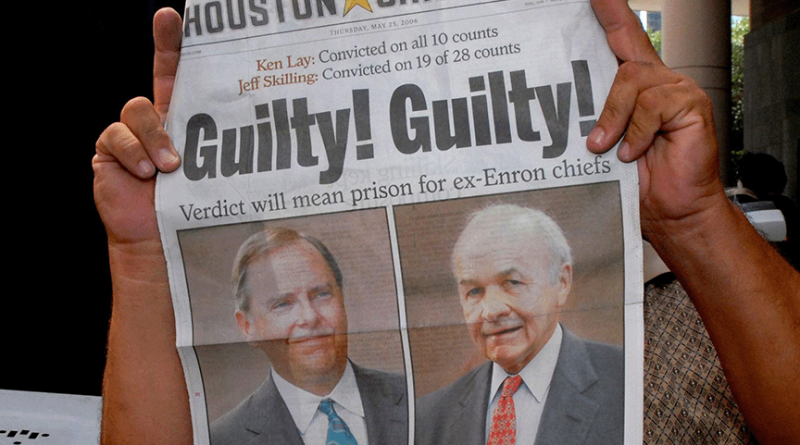Why are organisational cover-ups so common?
Anthony Montgomery is Professor in Occupational & Organisational Psychology at Northumbria University, Newcastle
The TV dramatization of the UK Horizon Post Office scandal evoked outrage and disbelief. However, as another example of dysfunctional organisational behaviour, it was expected rather than exceptional. The Post Office saga joins a long list of cover-ups or scandals that includes Hillsborough, Enron, Grenfell, the infected blood scandal, the Tuam babies scandal in the Republic of Ireland, Boeing 737 Max and NASA (Columbia space shuttle). They represent what happens when there is a move within organisations and institutions to cover up the causes of a tragedy.
The corporate drive to hide the truth is not random, but, I would say, inevitable. So why does it happen and why is it likely to keep happening?
Charlie Chaplin’s iconic movie Modern Times depicts humans as cogs in the wheel. The movie skewered scientific management of work movements (for example, that of engineer and author Frederick Taylor), which argued that work must be scientifically analysed to optimise efficiency.
Taylor’s theory stresses that employees should be assigned to perform one specific task, with scientific methods finding the single best way to perform that task. Managers directly supervise employees and employees are paid based on their performance.
The Enlightenment and Industrial Revolution contributed to a desire to apply scientific management to the organisation of work. Taylorism fed directly into our treatment of factory workers as elements in the workflow that needed to be monitored and controlled.
The ghost of Taylorism is evident in our increasing use of artificial intelligence (AI) to replace human labour. Chaplin understood that the machine metaphor was more than just better technology, it was a kind of template for how people ought to behave.
Stories about scandals vilify the people involved – ex-Post Office boss Paula Vennells is the most recent example. Individuals do carry responsibility, but blaming bad leaders is easier than accepting that institutions and governments are culpable.
My field (organisational behaviour) has contributed to this problem by being servants to industry. The mantra to measure, quantify and modify adds a sliver of scientific respectability to the fields of business and management. But it can lead to a blind spot around how organisational systems can evolve to damage people. Executive behaviour in the Enron, Boeing and the UK Post office scandals were motivated by ‘good’ business principles – protecting the company. Protecting institutions can seem ethical.
But organisational scandals are a reminder of what happens when efficiency is championed over personal experiences, and dysfunctional systems are defended. The Horizon Post Office scandal highlighted the worst elements of the scientific management culture in the ‘efficient’ way that the sub-postmasters were hounded.
It was also evident in the delay in getting to the truth because no one would admit that the technology could be wrong. This approach is nothing new. Initially, fans were blamed for Hillsborough, and pilots for the problems with Boeing 737 Max.
The corporate drive to hide the truth is not random, but inevitable. So why does it happen and why is it likely to keep happening?
Can organisations change?
In these scandals, the institutions and corporations skilfully control the narrative until their bubble of lies or incomplete accounts bursts. Enforced transparency and a fair playing field could break this pattern. A Hillsborough law, introducing a legally enforceable ‘duty of candour’ for police and public authorities in investigations, and equal legal funding for bereaved families at inquiries and inquests, would be one way to avoid the David versus Goliath journey.
The absence of convictions or meaningful repercussions following almost all scandals is abysmal. Restorative justice has a role to play, but wilfully perverting the course of public justice needs to be sanctioned.
We can’t depend on leaders to do the right thing if we keep educating them to put their mission first and people second. We promote and hire on the basis that leaders put their organisations first. The overused explanation of a ‘bad’ culture being responsible for dysfunctional organisations simply means that everybody clearly understood the real vision and objectives, and committed to doing what was needed.
Organisations frequently don’t want to talk about failures or even apparently to learn from them (we can take the Columbia space shuttle and 737 Boeing Max tragedies as examples of this). Similarly, employee silence is common and whistleblowing rare. The DNA of business education is flawed, with ethics and social justice seen as peripheral issues.
We need to start by accepting that organisations will do anything to maximise profit and shareholder value, and reverse-engineer from this point.
For example, accepting that accidents are likely can protect people from organisational dysfunction. Commercial air travel is one of the safest industries in the world, and the success is based on the fact that plane crashes are impossible to hide.
Aviation (like nuclear power operations and chemical industries) are called high-reliability organisations (HROs), which function nearly error-free in extremely challenging and uncertain environments.
The key to HROs is that procedures to protect people are mandatory and strictly enforced by experts. They start from the perspective that accidents are very likely if systems are not in place to prevent them.
Imagine how different the Horizon scandal might have been if the Post Office invited sub-postmasters to collaborate in monitoring the new system for potential flaws when it was introduced.
We don’t need a team of management consultants and policy advisers to understand that new work procedures might not begin perfectly. The biggest lie at the centre of most organisational failures – the Horizon Post Office scandal included – is that something unexpected and unpredictable happened.
This article first appeared in The Conversation.




